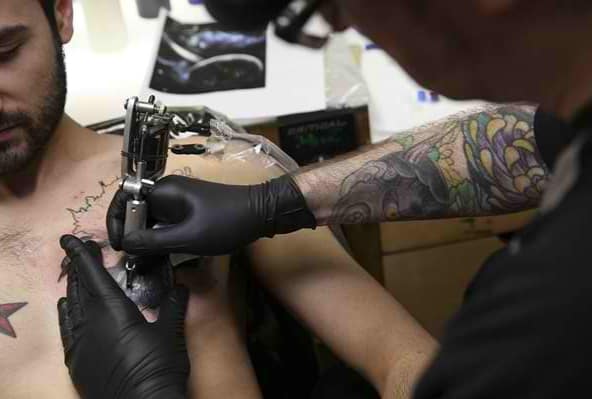
We think of tattoos as fixed adornments. Plunge ink deep enough into the skin and there it will sit, suspended in subterranean connective tissue forever.
But what if I told you that tattoos are actually maintained by an ever-changing process — one in which ink crystals are continuously engulfed, regurgitated and gobbled back up, merely giving the illusion of stasis?
That’s what French scientists observed from studying tatted mice. In their model of tattoo persistence, published Tuesday in the Journal of Experimental Medicine, macrophages — immune cells that ingest foreign or unhealthy debris in the body — play a starring role. Targeting these cells, the authors suggested, might help improve tattoo removal procedures for people.
As a tattoo is given, macrophages descend to capture invading ink. Probably because the ink granules are too bulky for the microscopic Pac-Mans to break down, they hold onto the pigment, your body art shining through their bellies.
With time, these original macrophages die and release their pigments, which get vacuumed up by new macrophages, starting the cycle over, said Sandrine Henri, a researcher at the Immunology Center of Marseille-Luminy who led the study with her colleague Bernard Malissen.

This research “shows that tattoos are in fact much more dynamic than we previously had believed,” said Johann Gudjonsson, a professor of immunology and dermatology at the University of Michigan who was not involved in the study.
The science behind your emblazoned anchor, sparrow or world map of places you’ve traveled has never fully been nailed down. For years, researchers suspected that tattoos worked by permanently staining fibroblasts, the cells that synthesize collagen, under the surface of our skin.
Then, looking at tattoo biopsies under the microscope, scientists saw macrophages laden with ink globules, and the story of tattoos became one of the immune system. Still, it was thought that tattoo-bearing macrophages were stable and long-lived, giving tattoos their permanence. What this study suggests is that, at least in mice, these macrophages are constantly being replaced.
Neither Henri nor Malissen have tattoos, and the pair didn’t set out to study them. They were examining skin cells in black mice for another project when they noticed macrophages scavenging the melanin released by dying, pigment-making cells. They wondered if the same process occurred in tattoos.
Tattooing green stripes on the tails of albino mice (via stick-and-poke), the immunologists confirmed that macrophages sequestered the ink. When they selectively killed off macrophages, the tail tattoos remained unchanged; new macrophages had come in and slurped up the freed pigments.
Next, the team grafted tattooed skin from one mouse onto another. After six weeks, most of the ink-laden macrophages on the graft were from the recipient mouse, not the donor — evidence that the macrophages had gone through a cycle of renewal.
The authors speculate that targeting macrophages might enhance laser removal, which can take as many as 20 treatments. An estimated 1 in 5 adults in the United States have at least one tattoo, and tens of thousands of laser removals are performed each year.
Jared Jagdeo, a dermatologist at the University of California, Davis, has also wondered whether macrophages impede tattoo removal by reabsorbing lasered ink particles. Since 2014, he has performed a laser removal procedure that uses anti-inflammatory ointment to suppress macrophages.
“It makes a difference,” he said.
But Nicholas Golda, a dermatologist at the University of Missouri School of Medicine, suggested other approaches might be simpler and more effective. Others have tried to promote tattoo inks that are more easily shattered by lasers, but these haven’t caught on because “tattoo artists weren’t interested in making it easier for people to remove their art,” he said.
And getting a tattoo of your lover’s name, knowing that it can be easily erased, just doesn’t pack the same romantic punch, does it?
For now, it seems, tattoos remain high-stakes, hard to reverse and sacred — but don’t mistake them for a fixed, unchanging part of your body.
